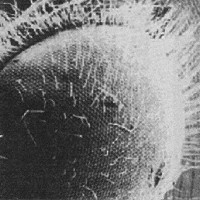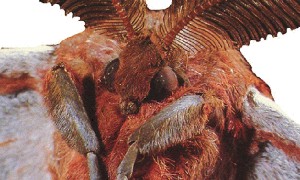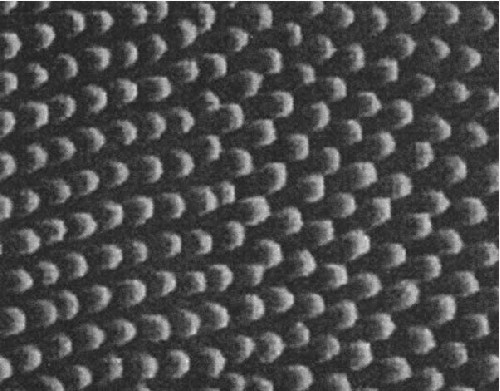lined link to go to subject)
Chapter 1. Vision
System Design
Chapter 2. Biological Eye Designs
Chapter
3. Eye
Design
Illustrations
A.
Plant
light sensing
1.
Grass, simple vines,
and stems
2.
Flowers
B.
Lower
animal eyes
1.
Flatworms
2.
Clams and Scallops
3.
Nautilus
4.
Shrimp
5.
Crab
6.
Octopus and
giant squid
7.
Spiders
8.
Scorpions
8.
Brittle Star
C.
Insect
eyes
1.
Bees
2. Dragonflies
3. Butterflies
4.
Flies
5.
Ants
6.
Moths
7.
Beetles
8.
Wasp
D. Fish
eyes
1.
Shark
2.
Flounder
3.
Four-eyed fish
E.
Amphibian
eyes
1. Frog
2.
Salamander
F.
Reptile
eyes
1. Boa
constrictor
2.
Rattle
snake
3.
Lizard
4.
Turtle
5.
Crocodile
and
alligators
G. Bird
eyes
1.
Eagles
2.
Hummingbirds
3. Owls
4.
Ostrich
5.
Cormorants
H.
Mammal
eyes
1.
Whales
2.
Elephants
3. Lions,
tigers, and
other cats
4.
Monkeys
5. Rats
and mice
6. Bats
7.
Tarsier
I.
Human
eyes
1. Iris
2. Lens
3.
Retina
Chapter
4. Eye
Reproduction
Chapter
5. Optical
Systems
Design
Chapter
6. The Eye Designer
Related
Links
Appendix
A - Slide Show & Conference Speech by Curt Deckert
Appendix
B - Conference Speech by Curt Deckert
Appendix
C - Comments From Our Readers
Appendix
D - Panicked Evolutionists: The Stephen Meyer Controversy
Chapter 3
Section C
(Click on PICTURE IN TEXT to bring up LARGE PICTURE)
3. EYE DESIGN ILLUSTRATIONS
C.
Insect
eyes
Insects have even more
different types of
eyes and vision systems than the less advanced animals we've
considered.
Many insects need to see in three dimensions while flying at high
speed.
Indeed, winged insects have better vision than wingless ones. The
variation
of eye size, resolution, and overall optical design in insects is also
great.
Many insects see a wider spectrum of colors than humans do. Their color
vision spectrum may vary from ultraviolet, in the case of the bee, to
near
infrared, in the case of some butterflies, and beetles. Insects need to
be able to see colors and shapes to find plants for food and
protection,
and to identify each other. Some plants are uniquely designed and
colored
to reflect UV light and other specific colors to attract suitable
insects
to carry out their significant role in pollinating flowers.
The many purposes for vision,
such as survival,
eating, protection, etc., result in eyes designed for the specific
environments
of each creature. For example, insect vision can take place at the rate
of up to 300 frames per second for fast-moving flying insects. This is
a significant design development, because of the size, speed,
field-of-view
of each facet, number of facets, and programming required for insects
to
function.
Many insects have compound eyes, similar to lobsters and other
arthropods.
Insect eyes are primarily apposition and superposition types. These
types
of optical designs are discussed in Section II. Here some acuity or
resolution
is sacrificed for increased sensitivity. There are also day vision and
night vision types of compound eyes and eye that are very versatile. A
wide variety of insect vision systems exist because of the extreme
variations
in size, function, and environment.
In some very small insects,
the density of
photoreceptors per square millimeter can be as large as in a human eye.
This provides for sensing of small images, even for insects, in very
small
packages. However, since these eyes are very small, there are fewer
total
photoreceptors than in human eyes, so there is much less total
resolution
over the whole field of vision. For example, it is very unlikely that
insects
can see stars in the sky.
Also, some small insects have
as large a density
of connections to the brain as in the human eye, but since the total
volume
is far less there are fewer connections. Connecting visual links in
some
insects may have more density than those contained in human eyes.
However,
depending upon the depth of focus, most insect compound eyes would have
to be more than 50 times larger than they are to match the overall
resolution
of the human eye. Because of this, insects may have vision that only
approaches
that of humans over a very limited field and distance.
Size and configuration of
insect eye optics
vary according to function. Because of fixed focus eyes, many insects
must
move in close to get a good view. Ideally, the resolution of
multi-faceted
eyes can be more uniform over the whole field of vision than that of a
camera eye, since these fixed focus eyes are made up of a large number
of smaller, somewhat independent, optical systems working together. The
facet size within an eye varies according to size and the specific
priority
of directional and field-of-view needs of a particular
insect.
Iridescent corneas are present
in some insect
eyes. These iridescent tin film filters pass some colors and block or
reflect
others. This allows insect photoreceptors to have varied and extended
color
capability. This effect can help insects see UV more clearly than human
eyes can. Optic lobes of insects also contain highly developed image
processors
for use by their small brains.
|
1. Bees
|

Honeybee Eyes. 
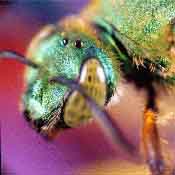

|
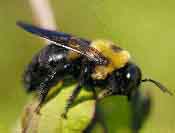
|

|
|
2. Dragonflies
|
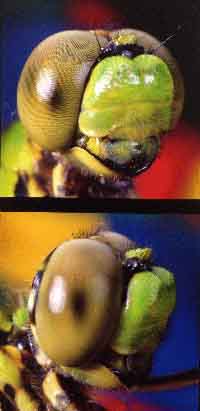
|
See Figure 3.15 for the damselfly eye design.
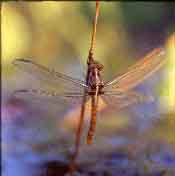
Full Wing. |
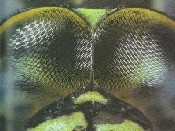
|
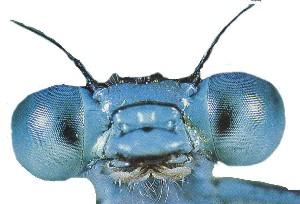
|
3. Butterflies
Depending on the species, small butterflies have either apposition eyes or some similar type of eye optics. Butterflies of various colors and designs need to see a wide spectrum of colors in order to find food, survive and multiply. Butterflies may have up to four different pigments in their eyes, as compared to two or three in many other insects. As a result, some butterflies have wide-spectrum color vision allowing them to see UV light reflected from specific flowers. Others can also see near-infrared-light beyond human color vision limits. They seem to respond to image color more than image detail, but their eyes have enough resolution to see fine patterns in flowers, and to see other butterflies in order to fly together. Some butterflies can see 30 micron (.03mm) details on objects, while the human eye can see details only in the range of 100 microns (.1mm). One possible reason for this variation is the large difference in eye focal lengths. The butterfly's eye, with short focal length, is able to focus closer than the human eye. Normally, human eyes can focus better at a longer distance, over a wider field, than butterfly eyes.
Butterfly eyes are shown on the following figure. There are some similarities with moth eyes shown in later chapters. (Figure 3.16 from p.110, Megabugs, The Natural History Museum book of insects, Barnes & Noble, N.Y., Miranda MacQuitty with Laurence Mound. Figure 3.16b & c, courtesy of www.pbrc.hawaii.edu/bemf (c)MicroAngela
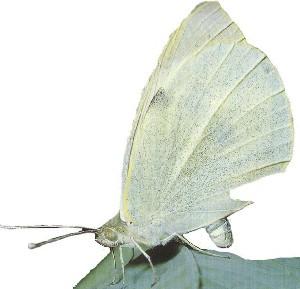
|
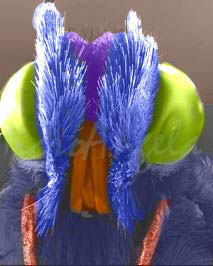
|

|
|
4. Flies Fruit flies have very small compound apposition eyes that require neural processing. They can sense rapid motion approaching 200 cycles per second. Considerable image processing is confined to a very small space. Fruit flies and other related specieshave been known to grow as many as three eyes, but we do not know if they can process with all three eyes. Third eyes may come from genetic errors due to induced genetic damage from toxic sprays, defective experimental genetic engineering or the normal background mutation rate from a very large number of experiments. It would be interesting to see if the third eye also contained the necessary programming in the brain to take advantage of improved overall sensitivity from the redundant eye. (P. 17, Megabugs, The Natural History Museum book of insects, Barnes & Noble, N.Y., Miranda MacQuitty with Laurence Mound. Figure 3.16b - e, courtesy of www.pbrc.hawaii.edu/bemf (c)MicroAngela ) |
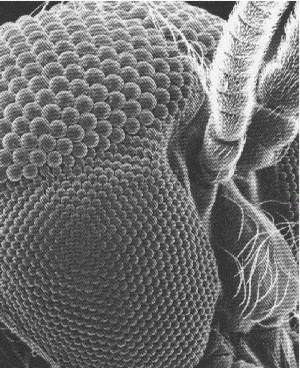
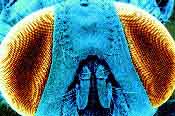
|
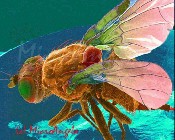
|

|

|
| Figures 3.17f, g, h, and i are photos of Flies eyes by Geoff Woodard, who has a number of excellent insect and other photos on the web. These photos illustrate some of the variations in fly eyes. The Navy is studying Fly Eyes to help develop guidance systems for weapons and more compact optical sensors. Hopefully, their intelligent vision processing will provide new technology for weapons, robotics, or other future applications. |
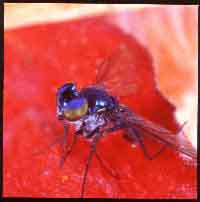
|
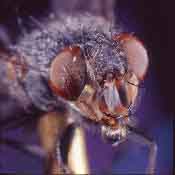
|

|

|
Most ants have poor vision because they have a smaller number of sensors for their vision. Their vision is comparable to a small fruit fly's. For example, at the low end of viewing capability, the dark-adapted underground ant has only nine facets per eye. But ants make good use of other senses such as smell, to supplement vision from their small apposition eyes. One would expect that their brains require considerable pre-programming of various operations, to coordinate their functions with limited vision.
| They also have a significant communication system as demonstrated by the way ants function together in groups such as army ants. The ant's visual processing system is very simple and compact for its unique purpose.(Fig 3.18 from P. 119, Megabugs, The Natural History Museum book of insects, Barnes & Noble, N.Y., Miranda MacQuiton with Laurence Mound. Fig 3.19 from Pg. 113 Bugs, Bloodsuckers, Bacteria and More by Peter Brookesmith, Barnes & Noble, 1999. Figure 3.19b, courtesy of www.pbrc.hawaii.edu/bemf (c)MicroAngela ) | 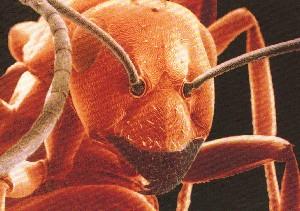
Eye detail |
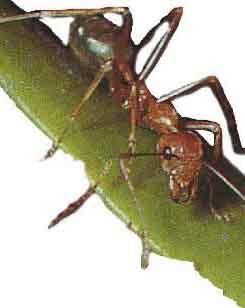
|
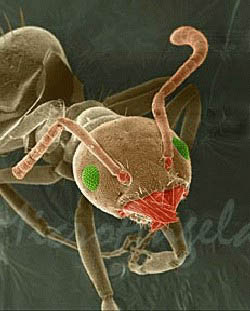
|
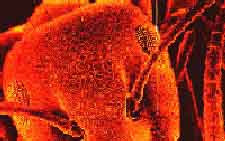
(From page 28-29 Creation, Dec 2001 to Feb 2002) |
7. Beetles
Beetles are expected to give scientists some new information on building efficient infrared detection systems. This could be used for night vision, fire detection, and other functions. Beetles use this capability to sense forest fires. Beetles have refraction superposition eyes which is a more advanced optical design as compared to apposition eyes. See figure 3.23 for a beetle eye. (Figure 3.23, p. 100, National Geographic, Vol. 193, No. 3, March 1998. Figure 3.23b courtesy of www.pbrc.hawaii.edu/bemf (c)MicroAngela B&W images colored for visual effect.).
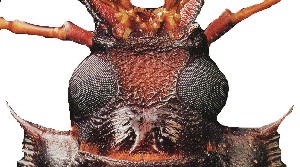
|
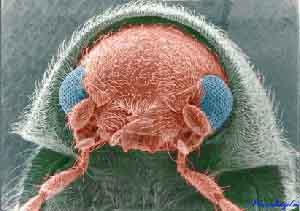
|
|
8.Wasp
Figures 3.23 is a photo of Wasp eyes by Geoff Woodard, who has a number of excellent insect and other photos on the web. These photos illustrate wide angle wasp eyes. A number of people are studying Wasp Eyes to learn more about their compact optical sensors and intelligent vision processing. Hopefully this work will provide new technology for future vision system applications. |
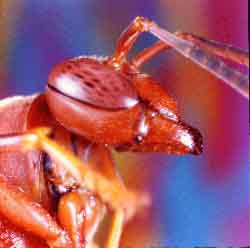
|
